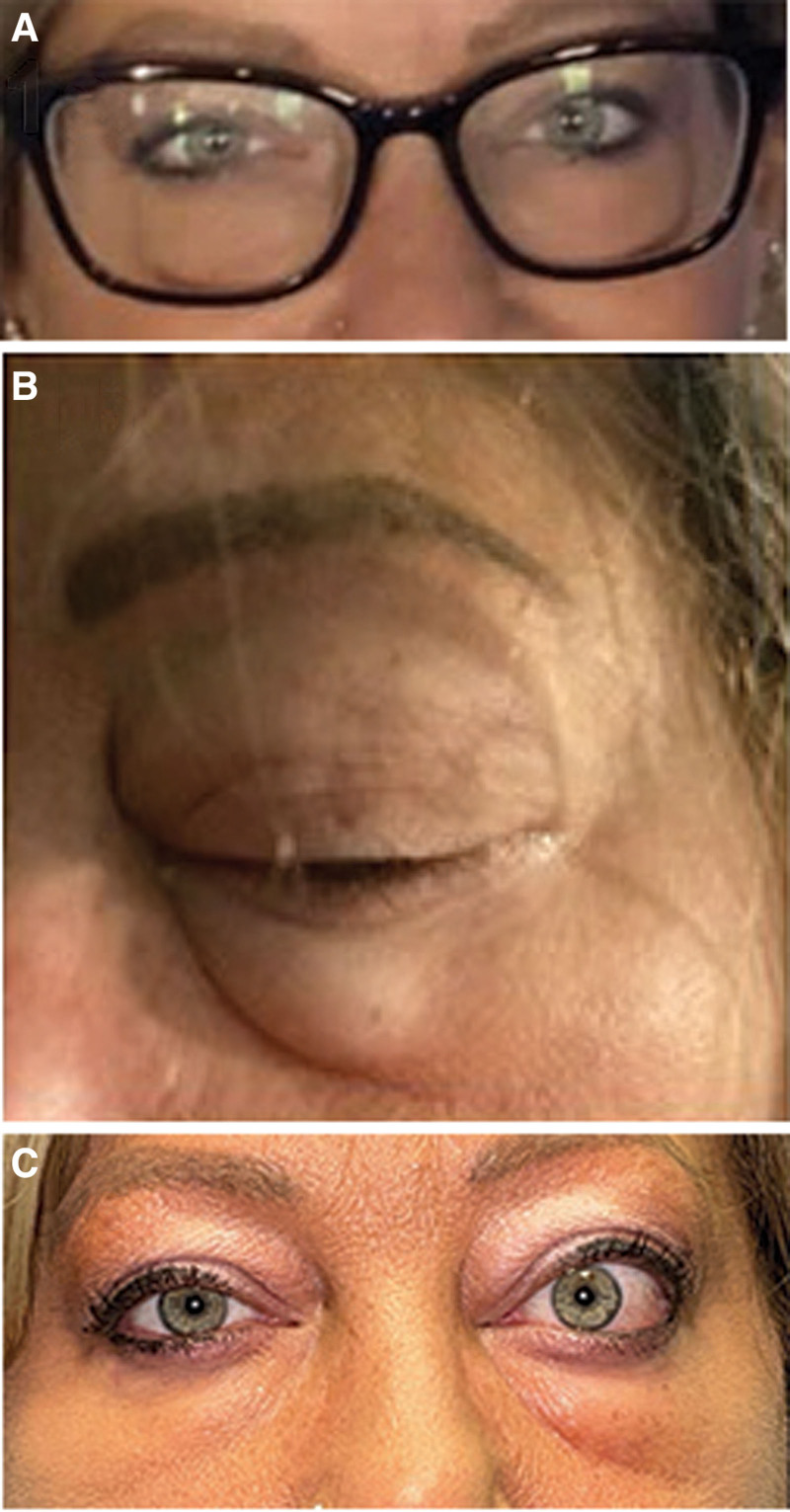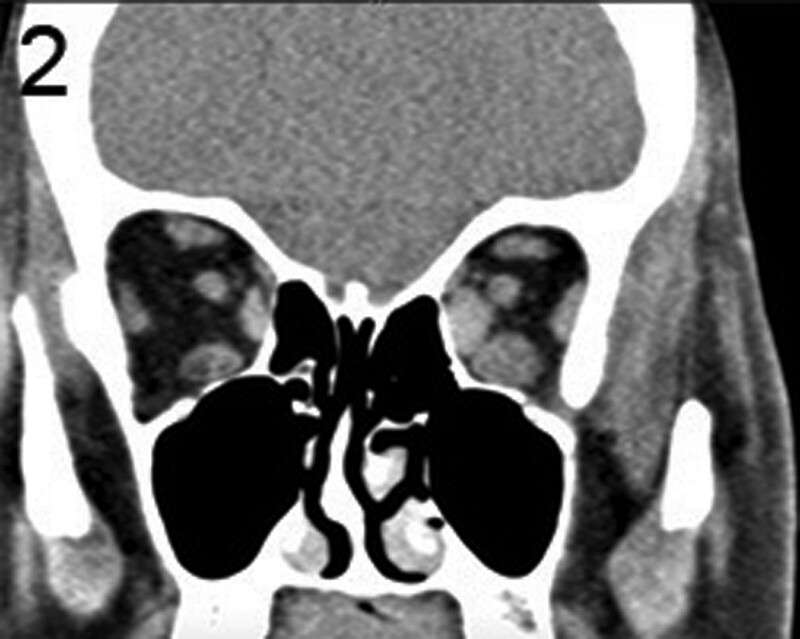Abstract
A 50-year-old woman with a history of controlled Graves’ disease without clinical ophthalmopathy presents with 2 months of left more than right periorbital swelling and proptosis. Her eye symptoms and signs began 3 days following her second vaccination against the COVID-19 virus. Orbital imaging, elevated thyroid stimulating immunoglobulin, and negative systemic work up for other diseases were consistent with a diagnosis of active thyroid eye disease. The temporal relationship to her vaccination was likely consistent with autoimmune/inflammatory syndrome associated with adjuvants. Clinicians should remind patients of the symptoms and signs of thyroid eye disease and to seek appropriate medical and ophthalmic advice if they occur after the COVID-19 vaccine.
Patient with history of Graves’ disease activates with thyroid eye disease after COVID-19 vaccination.
Thyroid eye disease (TED) is an orbital and periorbital manifestation of Graves’ disease, an autoimmune thyroiditis. The clinical course includes a spectrum of eye, eyelid, and orbital findings including dry eye, eyelid retraction, lagophthalmos, exposure keratitis, strabismus, exophthalmos, and vision loss.1 Treatment options are often dependent on the extent and activity of disease and include conservative care, immune suppression, teprotumumab (Tepezza, Horizon Pharmaceuticals, Deerfield, IL), radiotherapy, and surgery.
Recently, the coronavirus/COVID-19 pandemic has made caring for patients with TED difficult. The recent utilization of COVID-19 vaccinations protects against COVID-19 infections.2 Side effects have been well tolerated overall, but immune-related reactions have been noted, including autoimmune thyroiditis.3–5 To the knowledge of the author, this case is the first to represent the activation of TED in a patient with a history of Graves’ disease temporally related to the BNT162b2 mRNA (Pfizer) COVID-19 vaccine. The author was HIPAA complaint and adhered to the tenets of Helsinki.
CASE
A 50-year-old Caucasian, nonsmoking female presented to the author with 2 months of complains of eye irritation, tearing, visual changes, orbital pain, and proptosis of the eyes bilaterally, left more than right. She said that these symptoms occurred 3 days after receiving her second dose of the BNT162b2 mRNA (Pfizer) COVID-19 vaccine (Fig. 1A,B). She has a history of Graves’ disease without ophthalmopathy diagnosed in 2010 that was treated with radioactive iodine, in addition to hypertension, anxiety, and hypothyroidism treated with levothyroxine.
FIG. 1.
A, Patient’s photograph (taken with patient’s cell phone) 4 days before second BNT162b2 mRNA (Pfizer) Covid-19 vaccine indicating no obvious sign of clinical thyroid eye disease. B, Patient’s photograph (taken with patient’s cell phone) 3 days after the second dose of the vaccine indicating left periorbital edema. C, Clinical photograph of patient at presentation with the author’s practice about 2 months after her second vaccine dose, demonstrating left more than right periorbital edema, chemosis, left proptosis and left upper eyelid retraction with lateral flare.
On exam 2 months after initial symptoms, she had 20/25 vision OD and 20/20-2 OS at near with correction. She had no relative afferent pupillary defect. Ishihara plates were full each eye. Her motility was mildly reduced at abduction bilaterally, with pain with eye movement. Hertel exophthalmometer measurements were 20.5 OD, 22.5 OS, base 96. Both orbits were soft to retropulsion. Confrontational visual fields were full bilaterally. Her MRD1 was 5 mm right and 6-7 left with left lateral flare. She had no lagophthalmos. She had left more than right eyelid edema and erythema (Fig. 1C). She had 1+ chemosis right and 2+ left with 1+ conjunctival injection bilaterally. Her corneas had mild punctate epithelial erosions. Her optic nerves did not demonstrate edema or pallor. Automated 24-2 visual fields bilaterally were full bilaterally. Clinical activity score was 5.
Laboratory investigations obtained indicated normal thyroid stimulating hormone, T4, and free T3, but elevated thyroid stimulating immunoglobulin (2.29, normal range 0–0.55). Additional normal laboratory investigations included Quantiferon Gold for tuberculosis, RPR, RF, ACE, anti-proteinase3 antibody, anti-myeloperodixase antibody, and serum IgG4. She had an elevated ANA (1:320). CT scan of the orbits demonstrated left more than right enlarged inferior and medial recti muscles without tendon involvement or sinus disease (Fig. 2). She was started on intravenous teprotumumab. After the second dose, she had significant improvement in congestive symptoms, in addition to 1 mm reduction in proptosis of the OD and 3 mm of the left.
FIG. 2.
Coronal CT of the orbits demonstrating extraocular muscle enlargement consistent with thyroid eye disease.
DISCUSSION
As of late June 2021, the coronavirus pandemic has infected approximately 33 million people in the United States with over 600,000.6 This novel virus may cause a multitude of systemic disorders, including immune-related ones, such as autoimmune thyroiditis.7,8 The vaccines against COVID-19 have been increasingly reduced infections, but have potential for infrequent immune-related side effects, most famously thrombotic thrombocytopenia and myocarditis.3,4
Foreign substances (known as adjuvants, including vaccines) can trigger autoimmune and inflammatory conditions. This is known as autoimmune/inflammatory syndrome associated with adjuvants.9 This may be related to genetic predisposition or to the robust immune response by the substance. Just like the COVID-19 virus can lead to a “cytokine storm” and immune dysregulation, so can the vaccine.10
The COVID-19 vaccines have been related to subacute thyroiditis and acute thyroiditis.5,11,12 These patients were not noted to have symptoms or signs of TED. In this case, unlike the cases in the literature, the patient’s thyroid function levels were normal while being on chronic levothyroxine. She had elevated thyroid stimulating immunoglobulin, but it is unknown if this level was normal or abnormal prior to the COVID-19 vaccine. Eye symptoms, eye and orbital signs, and orbital imaging were consistent with TED. Systemic lab work did not indicate other causes, suggesting that the most likely diagnosis is activated TED in a patient with previously controlled Graves’ disease.
It is possible the relationship between the vaccine and the occurrence of TED was coincidental, as about 80% of reactivations of TED have no known etiology or stress as an etiology.13 This patient had no other recent changes to her thyroid function, pregnancy status, smoking status, or any recent surgery. However, the timing (within 1 week) of the vaccine and TED is similar to that of the previous reports of autoimmune thyroiditis after the COVID-19 vaccine. In addition, the pathogenesis of TED via immune stimulation due to the vaccine is consistent with prior reports of immune stimulation after the vaccine, as discussed.
COVID-19 virus has driven an unprecedented assault on the world’s status quo. The current vaccination effort in countries with robust vaccination programs is already showing a benefit. Certainly, all vaccinations have risks, and with the current reduction of cases associated with the vaccination efforts, the author believes that the benefits of the vaccines outweigh the risks. Certain populations, however, may have vulnerabilities that require informed consent prior to the vaccine and monitoring after. The author suggests that patients with prior history of autoimmune thyroiditis undergo a pre-COVID-19 vaccine ophthalmic baseline exam, in addition to understand that they may develop TED and require post-vaccine monitoring and/or treatment.
Footnotes
The author has received a prior honorarium from Horizon Pharmaceuticals.
REFERENCES
- 1.Roos JCP, Murthy R. Update on the clinical assessment and management of thyroid eye disease. Curr Opin Ophthalmol. 2019;30:401–406. [DOI] [PubMed] [Google Scholar]
- 2.Polack FP, Thomas SJ, Kitchin N, et al.; C4591001 Clinical Trial Group. Safety and efficacy of the BNT162b2 mRNA COVID-19 vaccine. N Engl J Med. 2020;383:2603–2615. [DOI] [PMC free article] [PubMed] [Google Scholar]
- 3.Abu Mouch S, Roguin A, Hellou E, et al. Myocarditis following COVID-19 mRNA vaccination. Vaccine. 2021;39:3790–3793. [DOI] [PMC free article] [PubMed] [Google Scholar]
- 4.Alam W. COVID-19 vaccine-induced immune thrombotic thrombocytopenia: a review of the potential mechanisms and proposed management. Sci Prog. 2021;104:368504211025927. [DOI] [PMC free article] [PubMed] [Google Scholar]
- 5.Iremli BG, Sendur SN, Unluturk U. Three cases of subacute thyroiditis following SARS-CoV-2 vaccine: post vaccination ASIA syndrome. J Clin Endocrinol Metab [Epub ahead of print May 27, 2021]. dgab373. doi: 10.1210/clinem/dgab373. [DOI] [PMC free article] [PubMed] [Google Scholar]
- 6.Centers for disease control and prevention. COVID data tracker. Available at: https://covid.cdc.gov/covid-data-tracker/#datatracker-home. Accessed June 19, 2021.
- 7.Murugan AK, Alzahrani AS. SARS-CoV-2 plays a pivotal role in inducing hyperthyroidism of Graves’ disease. Endocrine. 2021;9:1–12. [DOI] [PMC free article] [PubMed] [Google Scholar]
- 8.Harris A, Al Mushref M. Graves’ thyrotoxicosis following SARS-CoV-2 infection. AACE Clin Case Rep. 2021;7:14–16. [DOI] [PMC free article] [PubMed] [Google Scholar]
- 9.Watad A, David P, Brown S, et al. Autoimmune/Inflammatory syndrome induced by adjuvants and thyroid autoimmunity. Front Endocrinol (Lausanne). 2016;7:150. [DOI] [PMC free article] [PubMed] [Google Scholar]
- 10.Caron P. Thyroid disorders and SARS-CoV-2 infection: from pathophysiological mechanism to patient management. Ann Endocrinol (Paris). 2020;81:507–510. [DOI] [PMC free article] [PubMed] [Google Scholar]
- 11.Brancatella A, Ricci D, Viola N, et al. Subacute thyroiditis after Sars-COV-2 infection. J Clin Endocrinol Metab. 2020;105:dgaa276. [DOI] [PMC free article] [PubMed] [Google Scholar]
- 12.Vera-Lastra O, Ordinola Navarro A, Cruz Dominguez MP, et al. Two cases of Graves’ disease following SARS-CoV-2 vaccination: an autoimmune/inflammatory syndrome induced by adjuvants. Thyroid [Epub ahead of print May 3, 2021]. doi: 10.1089/thy.2021.0142. [DOI] [PubMed] [Google Scholar]
- 13.Patel P, Khandji J, Kazim M. Recurrent thyroid eye disease. Ophthalmic Plast Reconstr Surg. 2015;31:445–448. [DOI] [PubMed] [Google Scholar]




